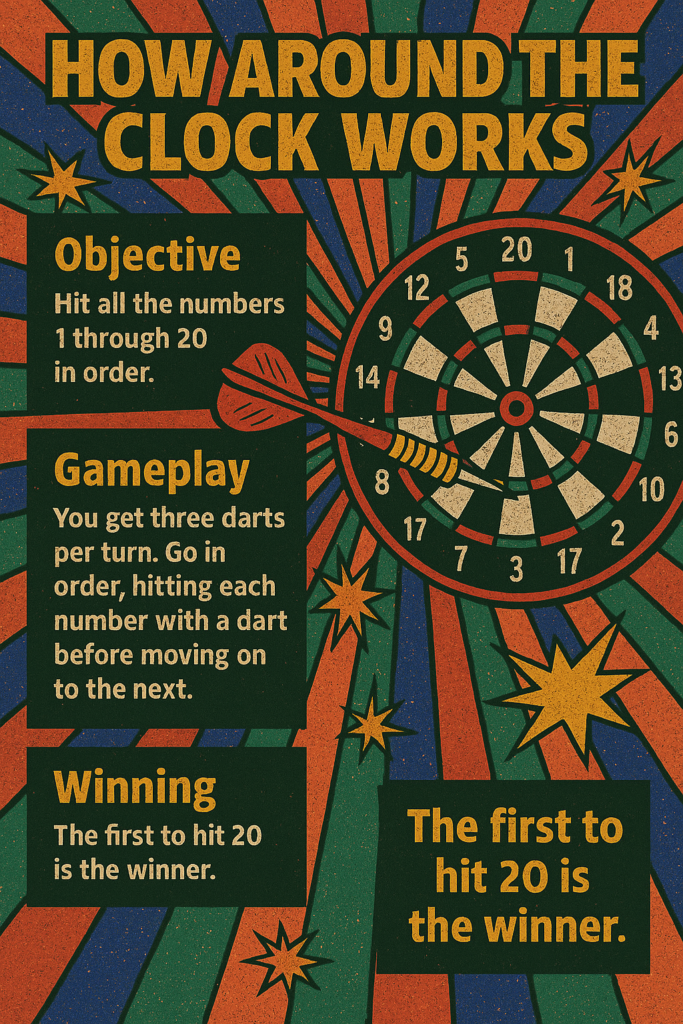Below is some detailed content for “Around the Clock,” also known as “Around the World.” This includes how to play, variations, and practical handicap options to balance skill levels.
Around the Clock (Around the World)
Objective
The goal of Around the Clock is to be the first player to hit every number on the dartboard in sequence—from 1 through 20—and then finish with the bullseye (or bull). Each player starts on number 1. Once you hit your current target, you move on to the next number in the sequence. If you fail to hit it, you stay on the same target until your next turn.
How to Play

- Setup
- Each player starts on the number 1.
- Decide turn order (e.g., throw closest-to-bull to see who goes first).
- Gameplay
- On your turn, you have three darts (standard).
- You must hit the number you are currently aiming for to advance to the next.
- For example, if you’re on 1 and you hit it, you move to 2 (even if you still have darts left in your turn). You can then aim for 2 within the same turn.
- This continues for all numbers up to 20, then you finish on the bullseye.
- Winning
- The first player to land the bullseye after hitting numbers 1 through 20 in order is the winner.
Gameplay Example
- Player A starts on 1. They throw dart one: it hits 1, so they move on to 2. Their second dart hits 2, they move on to 3. Their third dart misses 3, so they end their turn still needing 3 next round.
- Player B now throws at 1 (since they haven’t hit it yet). If they miss all three darts, they stay on 1 for their next turn.
This continues until someone completes all numbers and hits the bull.
Handicap Options
Around the Clock is a fantastic game for all skill levels, but differences in ability can make it unbalanced. Here are several ways to level the playing field:
- Starting Point Handicap
- Beginner Advantage: Let less experienced players start at number 1, while advanced players might start at number 5 or 10. This means the advanced player has more targets to hit before reaching 20 and the bull.
- Intermediate Adjustment: Perhaps novices start on 1, intermediates start on 3, and pros start on 6.
- Skip or Reduce the Bull
- For newcomers who struggle with the bull, you can opt to end at 20 instead of requiring the bullseye. This shaves off a tricky step for them but keeps the challenge for advanced players.
- Doubles or Trebles for Advanced Players
- If you have a highly skilled player in the group, let them only count a hit if it’s in the double or treble ring of the target number. Meanwhile, less experienced players can hit any part of the segment.
- Multiple Attempts for Beginners
- Give beginners the option of throwing extra darts for tough numbers. For example, “novices get 4 throws per turn instead of 3” or “every turn, novices can re-throw 1 dart that misses.”
- Custom Number Sequences
- Let advanced players follow a tougher sequence—maybe they have to go in odd numbers first (1, 3, 5…) then even numbers (2, 4, 6…) before heading to the bull. The beginner can simply follow the normal 1–20 sequence.
- Score Head Start
- If you’d like to mix scoring into it, you can assign each target a point value and give beginners a head start in points. For instance, the novice might start with 50 points while the advanced players start with 0. (Though typically Around the Clock is not a point-based game, this can be a fun variation.)
Tips for Making it Fun
- Speed Rounds: If you have many players, limit each turn to only 1 or 2 darts instead of 3 to keep the game flowing.
- Team Play: Pair a novice and an experienced player; they must alternate throws and work together to complete the sequence.
- Practice Mode: If you’re playing solo or with someone who wants to practice a particular section, focus on hitting specific numbers (e.g., 10–15) or add rules like “must hit double 10 then triple 11” to advance.
Around the Clock is straightforward, fast-paced, and excellent for mixed-ability groups, especially with handicap rules in place. Whether you’re aiming for the simple thrill of hitting numbers in order, or challenging yourself with doubles and trebles only, it’s a versatile game that can grow with your skill level.
